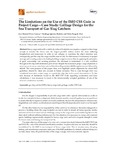The Limitations on the Use of the IMO CSS Code in Project Cargo—Case Study: Grillage Design for the Sea Transport of Gas Slug Catchers

Ver/
Use este enlace para citar
http://hdl.handle.net/2183/25522
A non ser que se indique outra cousa, a licenza do ítem descríbese como Atribución 4.0 Internacional (CC BY)
Coleccións
Metadatos
Mostrar o rexistro completo do ítemTítulo
The Limitations on the Use of the IMO CSS Code in Project Cargo—Case Study: Grillage Design for the Sea Transport of Gas Slug CatchersData
2020-04-29Resumo
[Abstract] Heavy cargo units with a relatively reduced footprint area require a support surface large enough to transfer the forces onto the largest possible surface and/or the main stiffening (longitudinal and transverse) in order to not collapse or overstress the ship’s structure and, consequently, put the ship, the cargo, and the crew at risk. For that reason, it is necessary to project stowage and securing systems (including bedding design) to ensure that, by applying the principles of good seamanship and securing practices, the shipment is maintained in a safe condition throughout the trip until destination port arrival. Despite the increase in project cargo shipments in recent years, in many cases, International Maritime Organization (IMO) regulations are followed by default. The main purpose of this paper, thus, is to highlight certain shipments for which IMO guidelines should be taken into account in future revisions. This is done through what was considered innovative project cargo on a particular ship due to its special characteristics. To this end, because of limitations found in the IMO CSS Code regarding acceleration and force calculations, it was necessary to resort to the internationally accepted guidelines of one of the strictest classification societies.
Palabras chave
Gas slug catcher(GSC)
Heavy cargo unit
Grillage
Cradle
CSS Code
Heavy cargo unit
Grillage
Cradle
CSS Code
Versión do editor
Dereitos
Atribución 4.0 Internacional (CC BY)
ISSN
2673-3161






